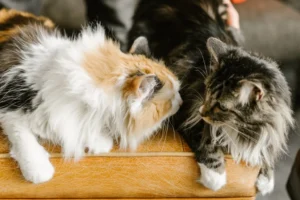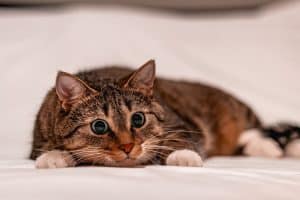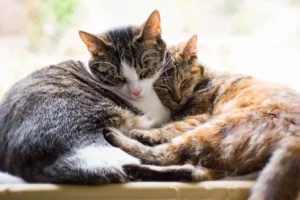Cats are fascinating creatures with unique features that set them apart from other animals. One of the most intriguing characteristics of cats is the varying lengths of their whiskers. Have you ever wondered why cats have whiskers of different lengths?
Evolutionary Purpose of Whiskers
Cats have different lengths of whiskers for a reason – it’s all about survival of the fittest! Back in the days when our feline friends were wild hunters, having varying lengths of whiskers served a crucial purpose.
The longer whiskers, located on their cheeks, help cats measure gaps and spaces when hunting or moving around in the dark. Think of them as a built-in measuring tool helping them avoid potential traps and dangers. On the other hand, the shorter whiskers near their eyes are more sensitive and assist in detecting subtle changes in the airflow, alerting them to any incoming threats or prey.
This evolutionary adaptation allows cats to navigate their surroundings with precision and excel in their stealthy hunting techniques. So, next time you marvel at your cat’s diverse whisker lengths, remember that it’s a testament to their remarkable hunting prowess!
Sensory Functions of Whiskers
Cats are not only fluffy companions but also master navigators, all thanks to their amazing whiskers! These facial hairs are not just for show – they play a crucial role in a cat’s sensory functions, helping them excel in their environment.
Whiskers are incredibly sensitive, acting as tactile sensors that aid in detecting changes in their surroundings. They help cats sense obstacles in their path and adjust their movements accordingly. Additionally, whiskers are vital in communicating with other animals, conveying mood and intentions through subtle movements.
Next time you observe your cat delicately brushing their whiskers against objects, they’re not just exploring – they’re gathering essential information about their environment. These multi-functional tools are a key part of a cat’s sensory toolkit, allowing them to thrive in their surroundings.
Growth and Shedding of Whiskers
Cats’ whiskers go through a growth cycle similar to their fur. These specialized hairs, called vibrissae, grow to a specific length and shed naturally to make way for new ones. Unlike fur, whiskers have a longer growth period and shed less frequently. This shedding process helps ensure that the whiskers remain at their optimal length for functionality.
Behavioral Significance of Whiskers
A cat’s whiskers are not just for show – they play a crucial role in communicating their mood and alertness levels. When a cat is relaxed, its whiskers are typically positioned forward. Conversely, if a cat is feeling threatened or stressed, the whiskers may be pulled back close to the face. Additionally, whiskers aid in spatial awareness, enabling cats to navigate their environment effectively. So, next time you see a cat’s whiskers twitch or move, remember that they are not just decorative – they are a vital tool for feline communication and behavior.
Additional Insight:
- Cats can use their whiskers to gauge whether they can fit through tight spaces. If a cat’s whiskers are as wide as their body, it’s a sign that they can safely pass through the area without getting stuck. So, the varying lengths of whiskers on a cat’s face serve a practical purpose beyond aesthetics.
Fun Facts About Whiskers
Did you know that a cat’s whiskers are not just for show? These specialized hairs, also known as vibrissae, are rooted deep in a cat’s body and are actually connected to their nervous system. This means that whiskers are incredibly sensitive and help cats navigate their surroundings with precision. They can even sense changes in airflow, alerting your feline friend to potential obstacles or prey nearby. Plus, whiskers are roughly as wide as a cat’s body, giving them an extra edge in tight spaces. So, next time you see your cat’s whiskers twitching, remember they’re not just cute accessories – they’re essential tools in your cat’s daily life!
Whiskers in Different Cat Breeds
While whiskers may seem consistent among all cats, the truth is that their length can vary depending on the breed. Maine Coon cats, known for their large size and friendly demeanor, tend to sport extra-long whiskers to match their big personalities. On the other hand, Siamese cats, with their sleek bodies and striking blue eyes, often have shorter whiskers in proportion to their faces. These variations in whisker length are thought to be influenced by genetics, as different breeds have evolved to excel in specific environments. So, whether your feline companion has whiskers for days or a more modest set, rest assured that their whiskers play a crucial role in their daily adventures.
- Sphynx Cat: This unique breed, known for its lack of fur, may have shorter and finer whiskers compared to other cats. Despite their whiskers being less noticeable, Sphynx cats still rely on them for sensory information.
- Persian Cat: With their luxurious coat and distinctive flat face, Persian cats often have shorter whiskers that complement their facial structure. These shorter whiskers don’t hinder their ability to explore and navigate their surroundings effectively. Remember, it’s not about the length of the whiskers, but how well they serve their purpose for each individual cat’s needs.
Whisker Care Tips for Cat Owners
Cat whiskers are not only adorable but also serve important sensory functions for your feline friend. To ensure your cat’s whiskers stay healthy and happy, follow these essential tips for whisker care:
- Grooming: Avoid trimming or plucking your cat’s whiskers, as this can disrupt their sense of balance and navigation.
- Healthy Diet: Provide a balanced diet rich in essential nutrients like protein and omega-3 fatty acids to support whisker growth.
- Regular Cleaning: Keep your cat’s whiskers clean by gently wiping them with a damp cloth to remove any dirt or debris.
- Avoid Stress: Minimize stress in your cat’s environment, as stress can lead to abnormal whisker shedding or stunted growth.
- Comfortable Environment: Ensure your cat has ample space to move around freely without damaging or bending their whiskers.
- Regular Vet Check-ups: Schedule regular veterinary check-ups to monitor your cat’s overall health, including the condition of their whiskers.
By following these whisker care tips, you can help promote healthy whisker growth and ensure your cat’s sensory system remains in top-notch condition.
Cat Whisker Myths Debunked
It’s time to set the record straight and debunk common myths surrounding cat whiskers. Let’s separate fact from fiction to better understand why cats whiskers are different lengths:
- Myth: Cutting a cat’s whiskers will make them grow back longer.
- Fact: Whiskers have a predetermined length and cutting them will not alter their growth.
- Myth: Whiskers are only for aesthetics.
- Fact: Whiskers are crucial sensory tools that help cats navigate their surroundings and detect changes in their environment.
- Myth: All cat whiskers are the same length.
- Fact: Cats have different lengths of whiskers to assist in sensing distances, hunting prey, and avoiding obstacles.
By debunking these myths, you can gain a deeper appreciation for the vital role that whiskers play in a cat’s life.
The Role of Whiskers in Cat Communication
Did you know that cats use their whiskers not just for balance and navigation, but also for communication? Whiskers are like a cat’s built-in radar system, helping them navigate and interact with their environment. Cats have specialized sensory receptors at the base of each whisker, allowing them to detect even the slightest changes in their surroundings.
When it comes to social interactions, cats use their whiskers to communicate with other animals and humans. For example, when a cat is feeling friendly and relaxed, their whiskers are typically positioned forward. On the other hand, if they are feeling scared or threatened, their whiskers may be pulled back close to their face. This subtle body language helps cats convey their emotions and intentions to those around them.
So, the next time you notice your cat’s whiskers twitching or moving, remember that they are not just there for decoration. They play a crucial role in how your feline friend navigates the world and communicates with you and other creatures. In essence, whiskers are like your cat’s very own superpower, enhancing their social interactions and relationships in ways we may not always notice.
Fun Fact: A cat’s whiskers are roughly as wide as its body, acting as a handy measuring tool for tight spaces and potential prey.
Alex, a passionate animal lover, has experience in training and understanding animal behavior. As a proud pet parent to two dogs and three cats, he founded AnimalReport.net to share insights from animal experts and expand his knowledge of the animal kingdom.









